Data Archive for GnG Validation during GMAP period (since late fall in 2020)
RIGC (Research Institute for Global Change), JAMSTEC supported by National fundings
Last update: 1603JST, 26 Jan 2021

RIGC (Research Institute for Global Change), JAMSTEC supported by National fundings
Last update: 1603JST, 26 Jan 2021

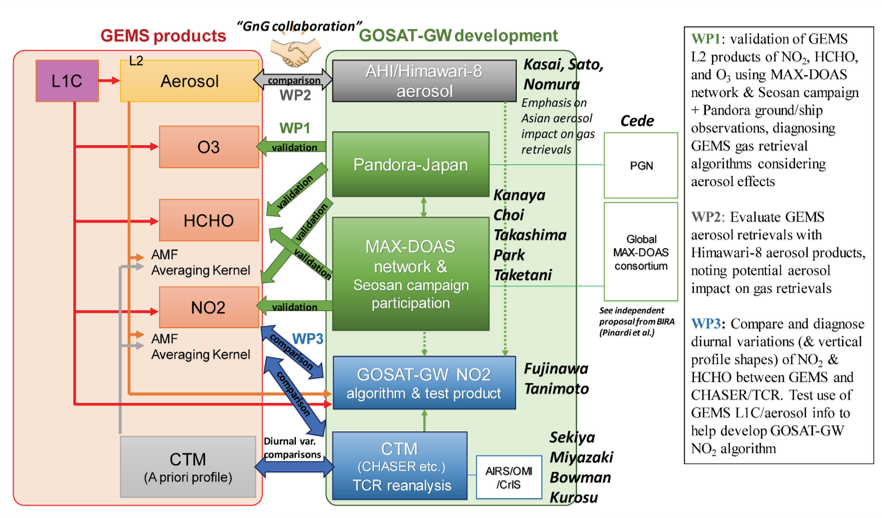
- To validate GEMS L2 products using ground-based remote sensing instruments (e.g., MAX-DOAS, Pandora, direct-sun DOAS, etc.)
- To monitor transported and local air pollutants using GEMS and sensors on multiple platforms
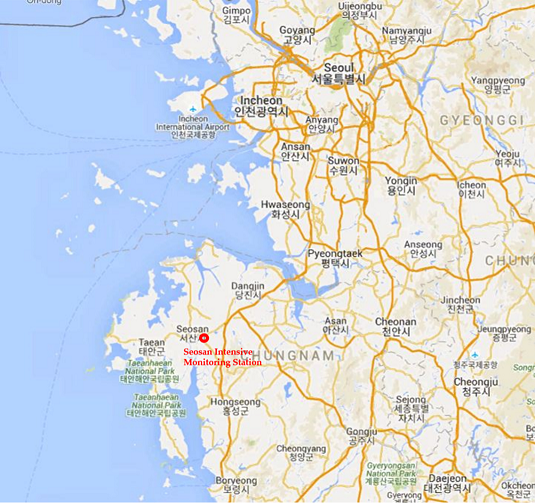
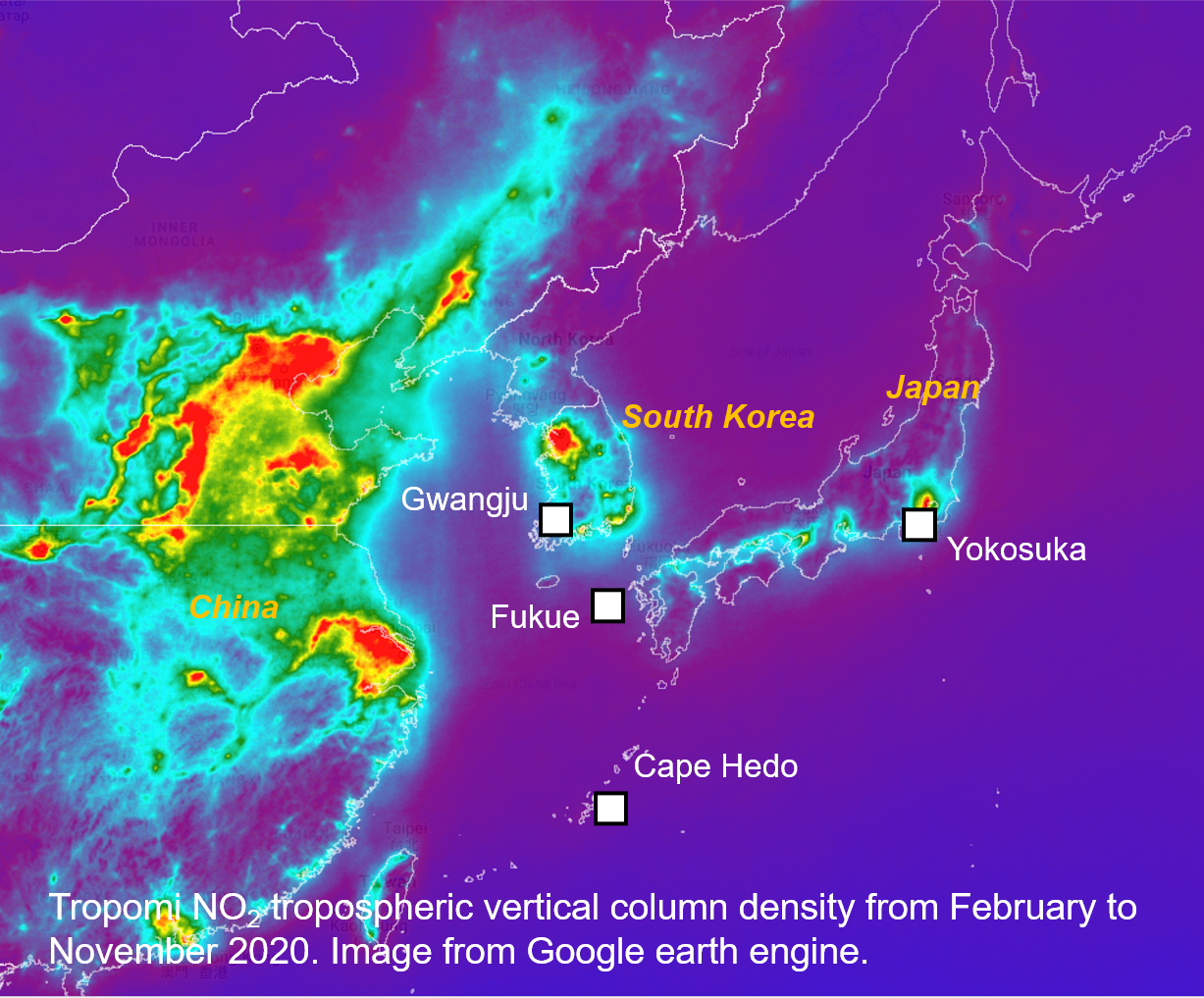
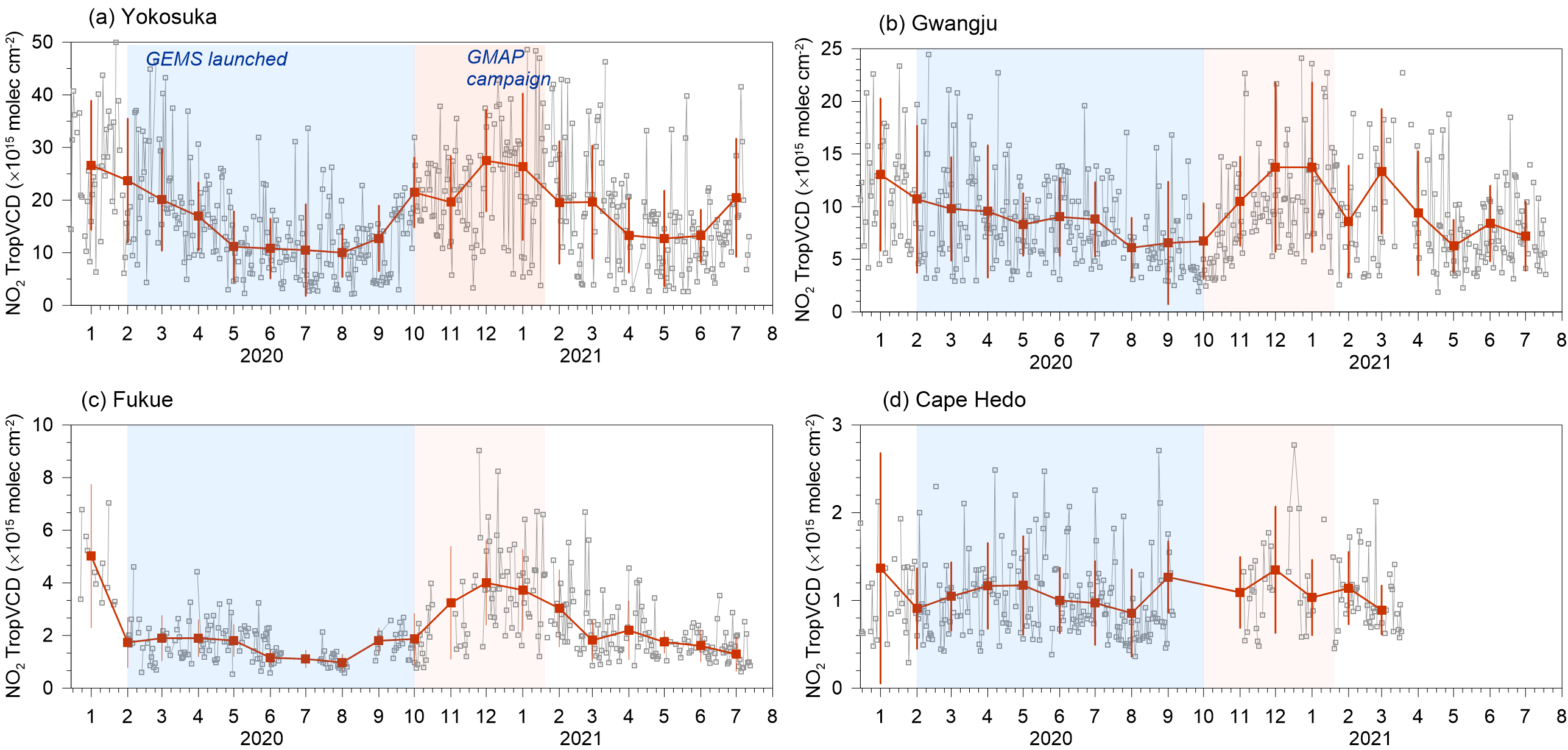

- MAX-DOAS (Multi-Axis Differential Optical Absorption Spectroscopy) monitoring network over Asia have established for long-term measurement by providing vertically-resolved (or integrated) trace gases and aerosol extinction.
- Yokosuka: until December 2020.
- Gwangju: until January 2021.
- Fukue: until November 2020.
- Cape Hedo: until October 2020.

- For downloading NO2 or O3 from Pandora at Yokosuka, you can easily find the data at PGN (Pandora Global Network) official site.
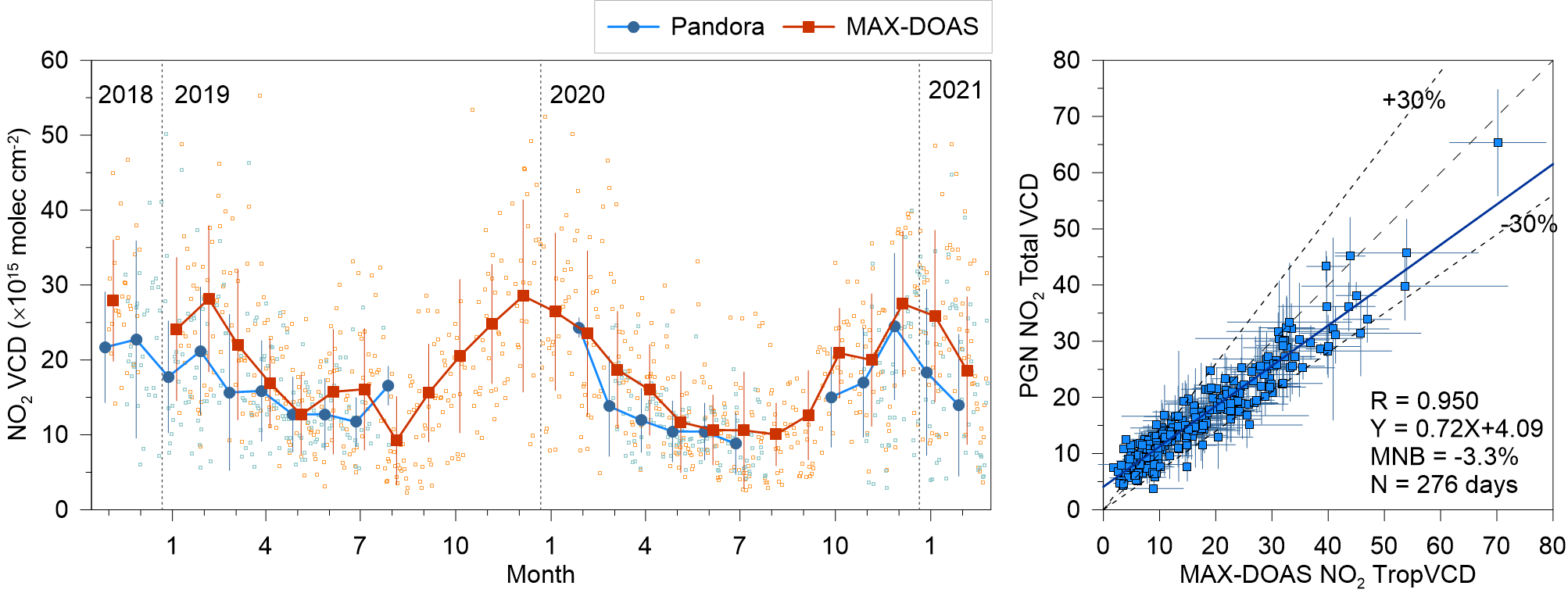
- Error codes: 8 digits; expressed as sum of them:
- 10000000= wrong mirror operation, incl power blackout
- 1000000 = integration time or temperature shifted
- 100000 = aerosol retrieval unsuccessful
- 10000 = fitting residual >5e-3
- 1000 = large stray light or spectrometer T anomaly 1
- 100 = spectrometer T anomaly 2
- 10 = raw signal >60000 in visible wavelength range
- 1 = NO2vcd retrieval failed
- Data users need to consent to the followings:
- Upon downloading, please report to Yugo Kanaya (yugo@jamstec.go.jp) for data update and permission for use. about the purpose of the data usage. This is to avoid possible overlaps of research scopes. Otherwise priority might not be provided to the data user for the pertinent analysis. We will do our best to assist data users by providing further information necessary for the analysis.
- Whenever the data are to be used for any publications or presentations, please report to Yugo Kanaya (yugo@jamstec.go.jp) in advance. Co-authorship should be provided to the data owners.
- Please include reference Kanaya et al. (2014).
- For Japanese sites, researcher located at JAMSTEC (Yugo Kanaya) is the owners for the data.
- For Korean site: Yugo Kanaya and Kihong Park
- Kanaya, Y., Irie, H., Takashima, H., Iwabuchi, H., Akimoto, H., Sudo, K., Gu, M., Chong, J., Kim, Y. J., Lee, H., Li, A., Si, F., Xu, J., Xie, P.-H., Liu, W.-Q., Dzhola, A., Postylyakov, O., Ivanov, V., Grechko, E., Terpugova, S., and Panchenko, M.: Long-term MAX-DOAS network observations of NO2 in Russia and Asia (MADRAS) during the period 2007-2012: instrumentation, elucidation of climatology, and comparisons with OMI satellite observations and global model simulations, Atmos. Chem. Phys., 14, 7909-7927, doi:10.5194/acp-14-7909-2014, 2014.
- Irie, H., Kanaya, Y., Akimoto, H., Iwabuchi, H., Shimizu, A., and Aoki, K.: First retrieval of tropospheric aerosol profiles using MAX-DOAS and comparison with lidar and sky radiometer measurements, Atmos. Chem. Phys., 8, 341–350, https://doi.org/10.5194/acp-8-341-2008, 2008.
- Irie, H., Kanaya, Y., Akimoto, H., Tanimoto, H., Wang, Z., Gleason, J. F., and Bucsela, E. J.: Validation of OMI tropospheric NO2 column data using MAX-DOAS measurements deep inside the North China Plain in June 2006: Mount Tai Experiment 2006, Atmos. Chem. Phys., 8, 6577–6586, https://doi.org/10.5194/acp-8-6577-2008, 2008.
- Irie, H., Takashima, H., Kanaya, Y., Boersma, K. F., Gast, L., Wittrock, F., Brunner, D., Zhou, Y., and Van Roozendael, M.: Eight-component retrievals from ground-based MAX-DOAS observations, Atmos. Meas. Tech., 4, 1027–1044, https://doi.org/10.5194/amt-4-1027-2011, 2011.
- Iwabuchi, H.: Efficient Monte Carlo Methods for Radiative Transfer Modeling, Journal of the Atmospheric Sciences, 63(9), 2324-2339, 2006.
- Roscoe, H. K., Van Roozendael, M., Fayt, C., du Piesanie, A., Abuhassan, N., Adams, C., Akrami, M., Cede, A., Chong, J., Clémer, K., Friess, U., Gil Ojeda, M., Goutail, F., Graves, R., Griesfeller, A., Grossmann, K., Hemerijckx, G., Hendrick, F., Herman, J., Hermans, C., Irie, H., Johnston, P. V., Kanaya, Y., Kreher, K., Leigh, R., Merlaud, A., Mount, G. H., Navarro, M., Oetjen, H., Pazmino, A., Perez-Camacho, M., Peters, E., Pinardi, G., Puentedura, O., Richter, A., Schönhardt, A., Shaiganfar, R., Spinei, E., Strong, K., Takashima, H., Vlemmix, T., Vrekoussis, M., Wagner, T., Wittrock, F., Yela, M., Yilmaz, S., Boersma, F., Hains, J., Kroon, M., Piters, A., and Kim, Y. J.: Intercomparison of slant column measurements of NO2 and O4 by MAX-DOAS and zenith-sky UV and visible spectrometers, Atmos. Meas. Tech., 3, 1629–1646, https://doi.org/10.5194/amt-3-1629-2010, 2010.
- Lee, H., H. Irie, J. Ryu, Y. Kanaya, Y. Noh, Y. J. Kim, S. Kwon, M. Trail, A. G. Russell, “Lower tropospheric aerosol measurements by MAX-DOAS during severe Asian dust period”, Aerosol Sci. Tech., 43 (12), 1208-1217 (2009).
- Irie, H., Y. Kanaya, H. Takashima, J. F. Gleason, and Z. Wang, “Characterization of OMI tropospheric NO2 measurements in East Asia based on a robust validation comparison”, SOLA, 5, 117-120 (2009).
- Takashima, H., H. Irie, Y. Kanaya, A. Shimizu, K. Aoki, and H. Akimoto, “Atmospheric aerosol variations at Okinawa Island in Japan observed by MAX-DOAS using a new cloud-screening method”, J. Geophys. Res., 114, D18213, doi:10.1029/2009JD011939. (2009). Irie, H., Y. Kanaya, H. Akimoto, H. Iwabuchi, A. Shimizu, and K. Aoki, “Dual-wavelength aerosol vertical profile measurements by MAX-DOAS at Tsukuba, Japan”, Atmos. Chem. Phys. 9, 2741-2749 (2009).
- Inomata, S., H. Tanimoto, S. Kameyama, U. Tsunogai, H. Irie, Y. Kanaya, and Z. Wang, “Technical Note: Determination of formaldehyde mixing ratios in air with PTR-MS: Laboratory experiments and field measurements”, Atmos. Chem. Phys., 8, 273-284 (2008).
- Wagner, T., Burrows, J. P., Deutschmann, T., Dix, B., von Friedeburg, C., Frieß, U., Hendrick, F., Heue, K.-P., Irie, H., Iwabuchi, H., Kanaya, Y., Keller, J., McLinden, C. A., Oetjen, H., Palazzi, E., Petritoli, A., Platt, U., Postylyakov, O., Pukite, J., Richter, A., van Roozendael, M., Rozanov, A., Rozanov, V., Sinreich, R., Sanghavi, S., and Wittrock, F.: Comparison of box-air-mass-factors and radiances for Multiple-Axis Differential Optical Absorption Spectroscopy (MAX-DOAS) geometries calculated from different UV/visible radiative transfer models, Atmos. Chem. Phys., 7, 1809–1833, https://doi.org/10.5194/acp-7-1809-2007, 2007.